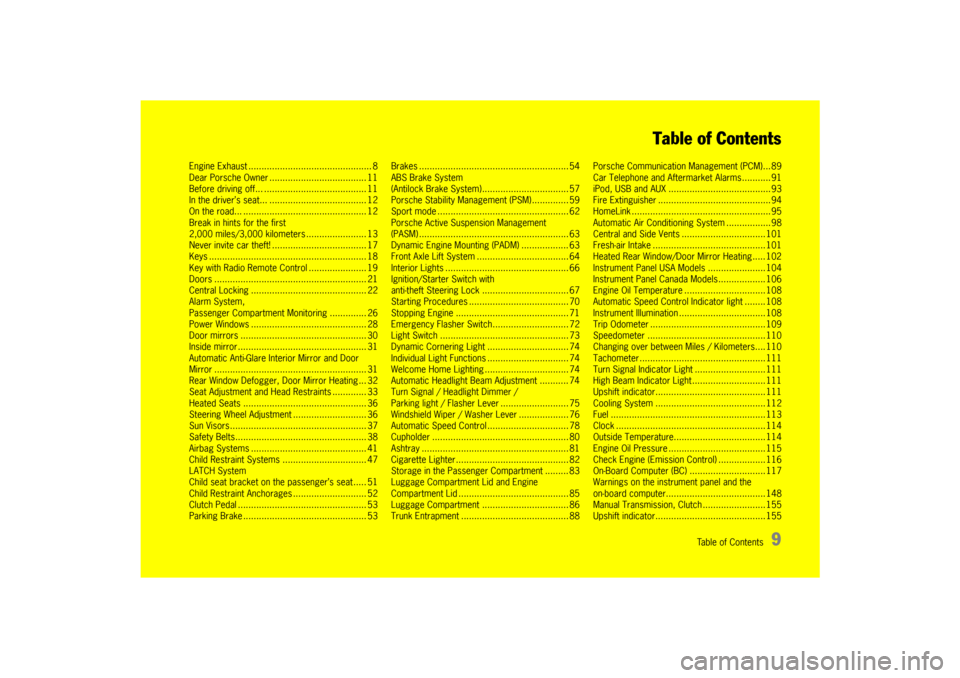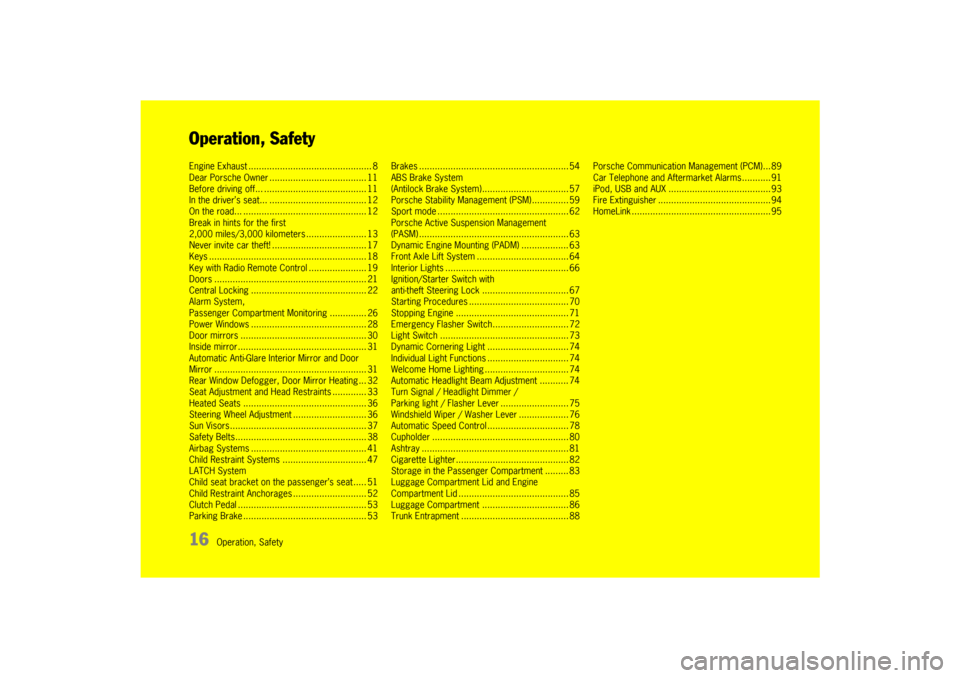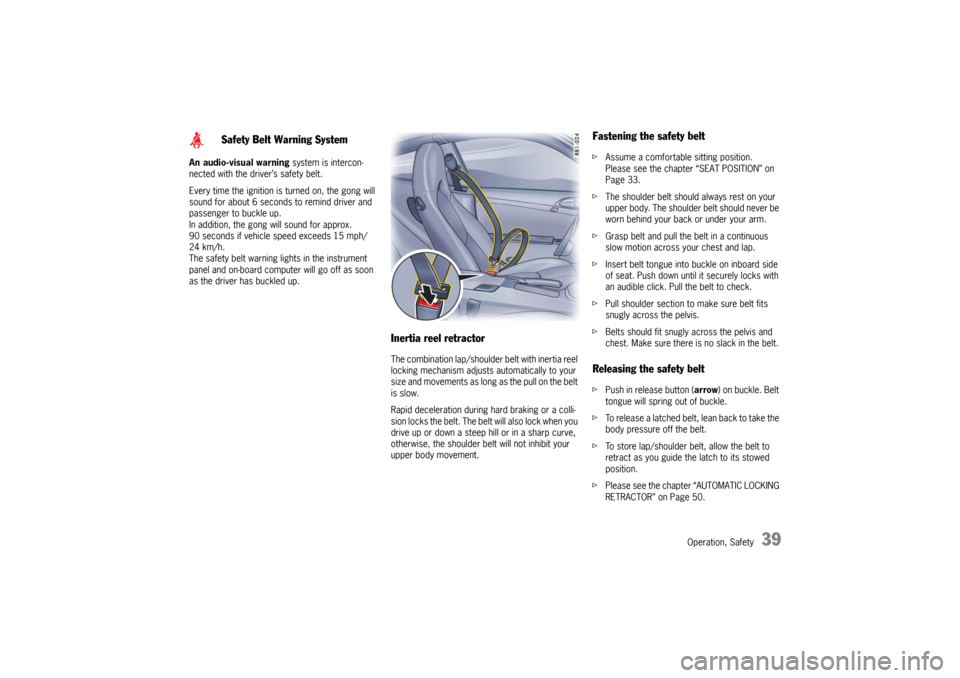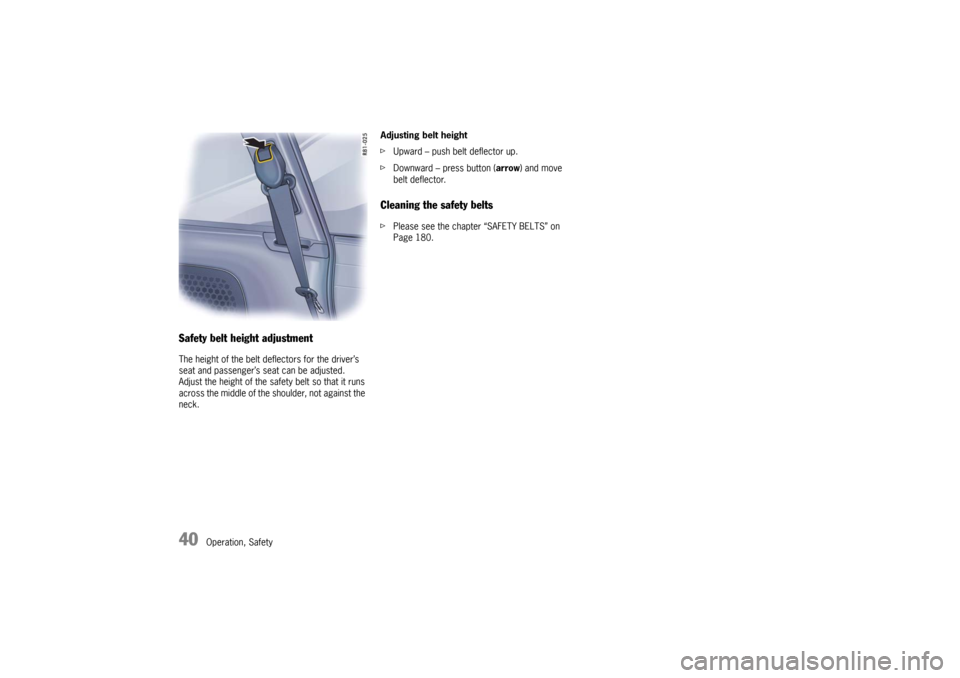belt PORSCHE 911 GT3 2010 5.G Owners Manual
[x] Cancel search | Manufacturer: PORSCHE, Model Year: 2010, Model line: 911 GT3, Model: PORSCHE 911 GT3 2010 5.GPages: 251, PDF Size: 14.33 MB
Page 3 of 251

2Dear Owner, We would like to thank you for your purchase of a
Porsche Sports car.
Judging by the car you have chosen, you are a
motorist of a special breed, and you are probably
no novice when it comes to automobiles.
Remember however, as with any vehicle, you
should take time to familiarize yourself with your
Porsche and its performance characteristics.
Always drive within your own unique capabilities as
a driver and your level of experience with your
Porsche. Ensure that anyone else driving your
Porsche does the same. To prevent or minimize
injury, always use your safety belts. Never
consume alcohol or drugs before or during the
operation of your vehicle.
This Owner’s Manual contains a host of useful
information. Please take the time to read this
manual before you drive your new Porsche.
Become familiar with the operation of your
Porsche car for maximum safety and operating
pleasure. The better you know your Porsche, the
more pleasure you will experience driving your
new car.
Always keep your Owner’s Manual in the car, and
give it to the new owner if you ever sell your
Porsche. A separate Maintenance Booklet explains how
you can keep your Porsche in top driving condition
by having it serviced regularly.
A separate Warranty and Customer Informa-
tion Booklet contains detailed information about
the warranties covering your Porsche.
For U.S. only:
If you believe that your vehicle has a fault which
could cause a crash, injury or death, you should
immediately inform the National Highway Traffic
Safety Administration (NHTSA) in addition to
notifying Porsche Cars North America, Inc.
(Porsche Cars N.A.).
If NHTSA receives similar complaints, it may open
an investigation, and if it finds that a safety
problem exists in a group of vehicles, it may order
a recall and remedy campaign. However, NHTSA
cannot become involved in individual problems
between you and your dealer, or
Porsche Cars N.A.
To contact NHTSA, you may call the Vehicle Safety
Hotline toll-free at 1-888-327-4236 (TTY: 1-800-
424-9153); go to http://www.safercar.gov; or
write to: Administrator,
NHTSA, 400 Seventh
Street, SW., Washington, DC 20590.
You can also obtain other information about motor
vehicle safety from http://www.savercar.gov.
Your car has thousands of parts and components
which have been designed and manufactured in
accordance with Porsche’s high standards of
engineering quality and safety.
Warning!
Any alteration or misuse of the vehicle can
lead to accidents and severe or fatal
personal injuries.
Any alteration of the vehicle may negate or
interfere with those safety features built into
the vehicle. Modifications may be carried out
on your vehicle only if approved by Porsche.
Your Porsche is intended to be used in a safe
manner obeying the local laws and in the
light of driving conditions faced by you, and
in accordance with the instructions provided
in this Owner’s Manual.
fDo not misuse your Porsche by ignoring those
laws and driving conditions, or by ignoring the instructions in this manual.
10_GT3_21.book Seite 2 Donnerstag, 4. Juni 2009 12:48 12
Page 7 of 251

6Service brakeBoth the standard brake system with composite
brake discs and the Porsche Ceramic Composite
Brake (PCCB) are high-performance brake
systems, designed specifically for driving on race
circuits.
Certain speeds, braking forces and ambient condi-
tions (e. g. temperature and humidity) therefore
might cause brake noises. This also applies after
completion of the running-in phase required for the
new brake components.
Wear on the different components of the braking
system, such as brake pads and brake discs,
depends to a great extent on the individual driving
style and the conditions of use and therefore
cannot be expressed in actual miles on the road.
The values communicated by Porsche are based
on normal operation adapted to traffic. Wear incre-
ases considerably when the vehicle is driven on
race tracks or through an aggressive driving style.
fPlease consult an authorized Porsche dealer
about the current guidelines in effect before
such use of your vehicle.
Aerodynamic componentsTo benefit from the high driving performance
without impairing the driving safety or the service
life of the vehicle components, certain vehicle
parts must be always fully operational while
driving.
fRegularly check your vehicle for signs of
damage.
Damaged, worn or missing aerodynamic
components such as spoilers or underside
panels affect driving behaviour and must there-
fore be replaced immediately.
To optimize the cooling of the brake discs, air
brake spoilers are fitted to the front and rear
running gear control arms as well as special air
brake ducts on the rear axle.
If these air-brake spoilers or air-brake ducts are
not fitted and there is a high thermal demand on
the braking system, the service life of the brake
discs could be reduced.
Brake wear expectations are based on normal
operations in street traffic. Wear increases consi-
derably when the vehicle is driven on race tracks
or with an aggressive driving style. Wear will also
increase considerably if the brakes are not
warmed up before being raced.
The aerodynamic stability of the vehicle is influ-
enced considerably at high speeds by the front lip.Due to the reduced ground clearance required for
optimization of road handling, the front lip and the
air-brake spoilers have to be placed in exposed
positions to fulfil their function. They can be
damaged, for example by ground or curbstone
contact.
SeatingYour car has two seats.
The area behind the seats is not intended for
passengers.
Danger!
In the event of an accident, serious personal
injury or death can result.
fNever allow anyone to sit in the area behind the
seats.
Persons occupying the area to the rear of the
two seats will not have a safety belt or airbag
protection, and in the event of an accident,
would be thrown around within or to the
outside of the vehicle compartment with
probable serious personal injury or death as the result.
10_GT3_21.book Seite 6 Donnerstag, 4. Juni 2009 12:48 12
Page 10 of 251

Table of Contents
9 Table of Contents
Engine Exhaust ............................................... 8
Dear Porsche Owner ..................................... 11
Before driving off... ....................................... 11
In the driver’s seat... ..................................... 12
On the road... ............................................... 12
Break in hints for the first
2,000 miles/3,000 kilometers ....................... 13
Never invite car theft! .................................... 17
Keys ............................................................ 18
Key with Radio Remote Control ...................... 19
Doors .......................................................... 21
Central Locking ............................................ 22
Alarm System,
Passenger Compartment Monitoring .............. 26
Power Windows ............................................ 28
Door mirrors ................................................ 30
Inside mirror ................................................. 31
Automatic Anti-Glare Interior Mirror and Door
Mirror .......................................................... 31
Rear Window Defogger, Door Mirror Heating ... 32
Seat Adjustment and Head Restraints ............. 33
Heated Seats ............................................... 36
Steering Wheel Adjustment ............................ 36
Sun Visors.................................................... 37
Safety Belts.................................................. 38
Airbag Systems ............................................ 41
Child Restraint Systems ................................ 47
LATCH System
Child seat bracket on the passenger’s seat ..... 51
Child Restraint Anchorages ............................ 52
Clutch Pedal ................................................. 53
Parking Brake ............................................... 53Brakes ......................................................... 54
ABS Brake System
(Antilock Brake System)................................. 57
Porsche Stability Management (PSM).............. 59
Sport mode .................................................. 62
Porsche Active Suspension Management
(PASM) ......................................................... 63
Dynamic Engine Mounting (PADM) .................. 63
Front Axle Lift System ................................... 64
Interior Lights ............................................... 66
Ignition/Starter Switch with
anti-theft Steering Lock ................................. 67
Starting Procedures ...................................... 70
Stopping Engine ........................................... 71
Emergency Flasher Switch............................. 72
Light Switch ................................................. 73
Dynamic Cornering Light ............................... 74
Individual Light Functions ............................... 74
Welcome Home Lighting ................................ 74
Automatic Headlight Beam Adjustment ........... 74
Turn Signal / Headlight Dimmer /
Parking light / Flasher Lever .......................... 75
Windshield Wiper / Washer Lever ................... 76
Automatic Speed Control ............................... 78
Cupholder .................................................... 80
Ashtray ........................................................ 81
Cigarette Lighter........................................... 82
Storage in the Passenger Compartment ......... 83
Luggage Compartment Lid and Engine
Compartment Lid .......................................... 85
Luggage Compartment ................................. 86
Trunk Entrapment ......................................... 88Porsche Communication Management (PCM)... 89
Car Telephone and Aftermarket Alarms........... 91
iPod, USB and AUX ....................................... 93
Fire Extinguisher ........................................... 94
HomeLink ..................................................... 95
Automatic Air Conditioning System .................98
Central and Side Vents ................................ 101
Fresh-air Intake ........................................... 101
Heated Rear Window/Door Mirror Heating..... 102
Instrument Panel USA Models ...................... 104
Instrument Panel Canada Models.................. 106
Engine Oil Temperature ............................... 108
Automatic Speed Control Indicator light ........ 108
Instrument Illumination................................. 108
Trip Odometer ............................................ 109
Speedometer ............................................. 110
Changing over between Miles / Kilometers.... 110
Tachometer ................................................ 111
Turn Signal Indicator Light ........................... 111
High Beam Indicator Light ............................ 111
Upshift indicator.......................................... 111
Cooling System .......................................... 112
Fuel ........................................................... 113
Clock .........................................................114
Outside Temperature................................... 114
Engine Oil Pressure ..................................... 115
Check Engine (Emission Control) .................. 116
On-Board Computer (BC)............................. 117
Warnings on the instrument panel and the
on-board computer...................................... 148
Manual Transmission, Clutch ........................ 155
Upshift indicator.......................................... 155
10_GT3_21.book Seite 9 Donnerstag, 4. Juni 2009 12:48 12
Page 13 of 251

12
Before driving off...
In the driver’s seat... fCheck operation of the horn.
fPosition seat for easy reach of foot pedals and
controls.
To reduce the possibility of injury from the
airbag deployment, you should always sit back
as far from the steering wheel as is practical,
while still maintaining full vehicle control.
fAdjust the inside and outside rear view mirrors.
fBuckle your safety belts.
fCheck operation of the foot and parking brake.
fCheck all warning and indicator lights with
ignition on and engine not running.
fStart engine and check all warning displays for
warning symbols.
fNever leave an idling car unattended.
fLock doors from inside, especially with
children in the car to prevent inadvertent
opening of doors from inside or outside.
Drive with doors locked.
On the road... fNever drive after you have consumed alcohol
or drugs.
fAlways have your safety belt fastened.
fAlways drive defensively.
Expect the unexpected.
fUse signals to indicate turns and lane changes.
fTurn on headlights at dusk or when the driving
conditions warrant it.
fAlways keep a safe distance from the vehicle in
front of you, depending on traffic, road and
weather conditions.
fReduce speed at night and during inclement
weather.
Driving in wet weather requires caution and
reduced speeds, particularly on roads with
standing water, as the handling characteristics
of the vehicle may be impaired due to hydropla-
ning of the tires.
fAlways observe speed limits and obey road
signs and traffic laws.
fWhen tired, get well off the road, stop and take
a rest. Turn the engine off. Do not sit in the
vehicle with engine idling.
Please see the chapter “ENGINE EXHAUST” on
Page 8.fWhen parked, always set the parking brake.
Move the gearshift lever to reverse or first
gear.
On hills also turn the front wheels toward the
curb.
fWhen emergency repairs become necessary,
move the vehicle well off the road. Turn on the
emergency flasher and use other warning
devices to alert other motorists. Do not park
or operate the vehicle in areas where the hot
exhaust system may come in contact with dry
grass, brush, fuel spill or other flammable
material.
fMake it a habit to have the engine oil checked
after every refueling.
10_GT3_21.book Seite 12 Donnerstag, 4. Juni 2009 12:48 12
Page 17 of 251

16
Operation, Safety
Operation, SafetyEngine Exhaust ............................................... 8
Dear Porsche Owner ..................................... 11
Before driving off... ....................................... 11
In the driver’s seat... ..................................... 12
On the road... ............................................... 12
Break in hints for the first
2,000 miles/3,000 kilometers ....................... 13
Never invite car theft! .................................... 17
Keys ............................................................ 18
Key with Radio Remote Control ...................... 19
Doors .......................................................... 21
Central Locking ............................................ 22
Alarm System,
Passenger Compartment Monitoring .............. 26
Power Windows ............................................ 28
Door mirrors ................................................ 30
Inside mirror ................................................. 31
Automatic Anti-Glare Interior Mirror and Door
Mirror .......................................................... 31
Rear Window Defogger, Door Mirror Heating ... 32
Seat Adjustment and Head Restraints ............. 33
Heated Seats ............................................... 36
Steering Wheel Adjustment ............................ 36
Sun Visors.................................................... 37
Safety Belts.................................................. 38
Airbag Systems ............................................ 41
Child Restraint Systems ................................ 47
LATCH System
Child seat bracket on the passenger’s seat ..... 51
Child Restraint Anchorages ............................ 52
Clutch Pedal ................................................. 53
Parking Brake ............................................... 53Brakes ......................................................... 54
ABS Brake System
(Antilock Brake System)................................. 57
Porsche Stability Management (PSM).............. 59
Sport mode .................................................. 62
Porsche Active Suspension Management
(PASM) ......................................................... 63
Dynamic Engine Mounting (PADM) .................. 63
Front Axle Lift System ................................... 64
Interior Lights ............................................... 66
Ignition/Starter Switch with
anti-theft Steering Lock ................................. 67
Starting Procedures ...................................... 70
Stopping Engine ........................................... 71
Emergency Flasher Switch............................. 72
Light Switch ................................................. 73
Dynamic Cornering Light ............................... 74
Individual Light Functions ............................... 74
Welcome Home Lighting ................................ 74
Automatic Headlight Beam Adjustment ........... 74
Turn Signal / Headlight Dimmer /
Parking light / Flasher Lever .......................... 75
Windshield Wiper / Washer Lever ................... 76
Automatic Speed Control ............................... 78
Cupholder .................................................... 80
Ashtray ........................................................ 81
Cigarette Lighter........................................... 82
Storage in the Passenger Compartment ......... 83
Luggage Compartment Lid and Engine
Compartment Lid .......................................... 85
Luggage Compartment ................................. 86
Trunk Entrapment ......................................... 88Porsche Communication Management (PCM)... 89
Car Telephone and Aftermarket Alarms........... 91
iPod, USB and AUX ....................................... 93
Fire Extinguisher ........................................... 94
HomeLink ..................................................... 95
10_GT3_21.book Seite 16 Donnerstag, 4. Juni 2009 12:48 12
Page 34 of 251

Operation, Safety
33
Seat Adjustment and Head
Restraints
Warning!
The seat may move unexpectedly if you
attempt to adjust while driving. This could
cause sudden loss of control, resulting in
serious personal injury or death.
fDo not adjust seats while the vehicle is in
motion.
The backrest locks must be engaged at all
times while the vehicle is in motion.
Safety belts only offer protection when the
backrest is upright and the belts are properly
positioned on the body.
Improperly positioned safety belts or safety
belts worn by passengers in an excessively
reclined position can cause serious personal
injury or death in an accident.
fDo not operate the car with the driver or
passenger backrests excessively reclined
(see “Seat position”).
Risk of injury if persons or animals are in the
movement range of the seat during seat
adjustment.
fAdjust the seat so that no one is put at risk.
Caution!
Risk of damage to windshield, sun visor, etc.
when the seat is adjusted or folded back or
forward.
fAdjust the seat so that the seat backrest is not in contact with any other object.
The driver and passenger seat provide integrated
head restraints in the backrests. The head
restraints are not adjustable. Warning!
All occupants, including the driver, should not
operate a vehicle or sit in a vehicle's seat until the
head restraints and backrests, respectively, are
placed in their proper positions so that the risk of
neck injuries is minimized in the event of a crash.
For proper positioning of the head restraint, the
seatback's inclination should be adjusted such
that the head restraint is in an upright position.
Driver and passengers should be seated upright
and in the center of their seats.
Seat positionAn ergonomically correct sitting position is
important for safe and fatigue-free driving.
We recommend the following procedure for adjus-
ting the driver’s seat to suit individual
requirements:
1. Adjust the seat until, with the clutch pedal fully
depressed, your leg remains at a slight angle.
2. Rest your outstretched arm on the steering
wheel.
Set the backrest angle (not applicable for
Sports bucket seat) and the steering-wheel
position so that your wrist rests on the outer
rim of the steering wheel. At the same time,
the shoulders must still be in noticeable
contact with the backrest.
3. Adjust the seat height (not applicable for
Sports bucket seat) to give yourself enough
headroom and a good overview of the vehicle.
4. Electrically adjustable seat:
Adjust the seat angle until your thighs rest
lightly on the seat cushion.
10_GT3_21.book Seite 33 Donnerstag, 4. Juni 2009 12:48 12
Page 39 of 251

38
Operation, Safety
Safety Belts
Warning!
Always make sure your and your passenger’s
safety belts are properly fastened while
seated in the vehicle.
Failure to follow safety belt warnings may
result in serious personal injury or death.
fFor your and your passenger’s protection, use
safety belts at all times while the vehicle is in
motion.
fUse appropriate child restraint systems for all
small children.
Proper wearing of safety belts
fS a f e t y b e l t s m u s t b e p o s i t i o n e d o n t h e b o d y a s
to restrain the upper body and lap from sliding
forward. Improperly positioned safety belts
can cause serious personal injury or death in
case of an accident.
fThe shoulder belt should always rest on your
upper body. The shoulder belt should never be
worn behind your back or under your arm.
fFor maximum effectiveness, the lap belt
should be worn low across the hips.
fPregnant women should position the belt as
low as possible across the pelvis. Make sure it
is not pressing against the abdomen. fBelts should not be worn twisted.
fDo not wear belts over rigid or breakable
objects in or on your clothing, such as eye
glasses, pens, keys, etc. as these may cause
injury.
fSeveral layers of heavy clothing may interfere
with proper positioning of belts.
fBelts must not rub against sharp objects or
damage may occur to the belt.
fTwo occupants should never share the same
belt at the same time.
Care and maintenance
fKeep belt buckles free of any obstruction that
may prevent a secure locking.
fBelts that have been subjected to excessive
stretch forces in an accident must be
inspected or replaced to ensure their conti-
nued effectiveness in restraining you.
The same applies to belt tensioner systems
which have been triggered.
In addition, the anchor points of the belts
should be checked.
fIf safety belts do not work properly, see your
authorized Porsche dealer immediately.
fI f t h e b e l t s s h o w d a m a g e t o w e b b i n g , b i n d i n g s ,
buckles or retractors, they should be replaced
to ensure safe operation.
fDo not modify or disassemble the safety belts
in your vehicle. fThe belts must be kept clean or the retractors
may not work properly.
Please see the chapter “CAR CARE INSTRUC-
TIONS” on Page 174.
fNever bleach or dye safety belts.
fDo not allow safety belts to retract until they
are completely dry after cleaning or this may
cause damage to the belt.
Belt tensioner Depending on the force of an impact, fastened
safety belts are tightened in an accident.
The belt tensioners are triggered in:
– Front, side and rear impacts of sufficient
severity.
Note
The belt-tensioner system can be triggered only
once; the system must be replaced afterward.
If there is a fault in the belt-tensioner system, the
airbag warning light lights up.
Work may be performed on the belt-tensioner
system only by an authorized Porsche dealer.
Smoke is released when the belt tensioners are
triggered. This does not indicate a fire in the
vehicle.
10_GT3_21.book Seite 38 Donnerstag, 4. Juni 2009 12:48 12
Page 40 of 251

Operation, Safety
39
An audio-visual warning system is intercon-
nected with the driver’s safety belt.
Every time the ignition is turned on, the gong will
sound for about 6 seconds to remind driver and
passenger to buckle up.
In addition, the gong will sound for approx.
90 seconds if vehicle speed exceeds 15 mph/
24 km/h.
The safety belt warning lights in the instrument
panel and on-board computer will go off as soon
as the driver has buckled up.
Inertia reel retractor The combination lap/shoulder belt with inertia reel
locking mechanism adjusts automatically to your
size and movements as long as the pull on the belt
is slow.
Rapid deceleration during hard braking or a colli-
sion locks the belt. The belt will also lock when you
drive up or down a steep hill or in a sharp curve,
otherwise, the shoulder belt will not inhibit your
upper body movement.
Fastening the safety beltfAssume a comfortable sitting position.
Please see the chapter “SEAT POSITION” on
Page 33.
fThe shoulder belt should always rest on your
upper body. The shoulder belt should never be
worn behind your back or under your arm.
fGrasp belt and pull the belt in a continuous
slow motion across your chest and lap.
fInsert belt tongue into buckle on inboard side
of seat. Push down until it securely locks with
an audible click. Pull the belt to check.
fPull shoulder section to make sure belt fits
snugly across the pelvis.
fBelts should fit snugly across the pelvis and
chest. Make sure there is no slack in the belt. Releasing the safety beltfPush in release button (arrow) on buckle. Belt
tongue will spring out of buckle.
fTo release a latched belt, lean back to take the
body pressure off the belt.
fTo store lap/shoulder belt, allow the belt to
retract as you guide the latch to its stowed
position.
fPlease see the chapter “AUTOMATIC LOCKING
RETRACTOR” on Page 50.
Safety Belt Warning System
10_GT3_21.book Seite 39 Donnerstag, 4. Juni 2009 12:48 12
Page 41 of 251

40
Operation, Safety
Safety belt height adjustmentThe height of the belt deflectors for the driver’s
seat and passenger’s seat can be adjusted.
Adjust the height of the safety belt so that it runs
across the middle of the shoulder, not against the
neck. Adjusting belt height
fUpward – push belt deflector up.
fDownward – press button (arrow) and move
belt deflector.
Cleaning the safety beltsfPlease see the chapter “SAFETY BELTS” on
Page 180.
10_GT3_21.book Seite 40 Donnerstag, 4. Juni 2009 12:48 12
Page 42 of 251

Operation, Safety
41
Airbag SystemsThe airbags in combination with the safety belts
make up a safety system which offers the driver
and the passenger the greatest known protection
from injuries in case of accident.
Your vehicle is equipped with a weight sensing
system for the passenger's seat in accordance
with U.S. Federal Motor Vehicle Safety Standard
208.
Even if your vehicle is equipped with airbags, the
safety belts must be worn at all times,
because the front airbag system is only deployed
by frontal collisions with an impact of sufficient
severity.
Below the deployment threshold of the airbag
system, and during types of collisions which do
not cause the actuation of the system, the safety
belts provide the primary protection to the occup-
ants when correctly worn.
Therefore, all persons within the vehicle
must wear safety belts at all times (in many
states, state law requires the use of safety belts).
fPlease see the chapter “SAFETY BELTS” on
Page 38.
The front airbags are located under the padded
steering wheel panel on the driver’s side and, on
the passenger's side, in the dashboard.
The side airbags for the front seats are installed
on the side in the seat backrests.
The head airbags are installed in the door linings.
Danger!
To provide optimal occupant protection,
airbags must inflate at very high speed. If
you are not wearing your safety belt or are
too close to the airbag when it is deployed,
inflating airbags can result in serious
personal injury or death.
fMake sure there are no people, animals or
objects between the driver or passenger and
the area into which the airbag inflates.
fSit back as far from the dashboard or steering
wheel as is practical, while still maintaining full
vehicle control.
fAlways hold the steering wheel by the outer
rim. Never rest your hands on the airbag panel.
fAlways fasten seat belts because triggering
of the airbag system depends on the force and
angle of impact.
fDo not transport heavy objects on or in front of
the passenger’s seat. These could impair the
function of the airbag, the seat belts, and
weight sensing.
fDo not hang objects (e.g. jackets, coats, coat
hangers) over the backrest.fAlways keep the lid of the door storage
compartment closed. Objects must not
protrude out of the door storage compart-
ment.
fDo not add any additional coverings or stickers
to the steering wheel or in the area of the
passenger’s airbag, side airbags and head
airbags. Doing so may adversely affect the
functioning of the airbag system or cause
harm to the occupants if the airbag system
should deploy.
Do not use protective seat covers.
fDo not modify the seat coverings. Do not
attach additional cushions, protective cover-
ings, or pillows to the passenger's seat. Do not
affix things to the passenger's seat or cover it
with other materials. Do not cover the back of
the backrest. Do not make changes to the
passenger's seat and to the seat base frame.
fNo changes may be made to the wiring or
components of the airbag system.
fDo not install any wiring for electrical acces-
sory equipment in the vicinity of the airbag
wiring harnesses. Doing so may disable the
airbag system or cause inadvertent inflation.
fIf the warning light comes on, the airbag
system should be repaired immediately by
your authorized Porsche dealer.
10_GT3_21.book Seite 41 Donnerstag, 4. Juni 2009 12:48 12